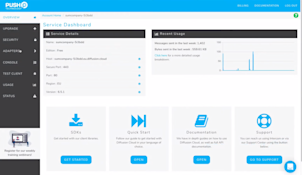Google Cloud Pub/Sub vs Push Technology
This Google Cloud Pub/Sub vs Push Technology comparison was created based on reviews from developers and our best attempts to perform analysis by looking at documentation and other publicly available resources.
Easily build complete, trusted realtime functionality.
Take our APIs for a spin Google Cloud Pub/Sub |  Push Technology | |
|---|---|---|
| Getting started and developer experience | ||
Time to "hello world" Reviewed by 3+ independent developers Ratings were given based on the average amount of time it takes to sign up to a new account and publish the first message. | 4 / 5 5 = <30 min | 4 / 5 5 = <30 min |
Demos / Tutorials A selection of online demos and tutorials so you can test and see the code in action. Explore Ably's tutorials for our pub/sub messaging platform | ||
Documentation Reviewed by 3+ independent developers Explore Ably's documentation for our pub/sub messaging platform | 4.33 / 5 Getting started guides / 5 Information architecture and developer journey / 5 API reference documentation / 5 Readability, design and navigation / 5 Quality of code / 5 Breadth and quality of tutorials / 5 “The docs are neatly organized, with the information split and presented in a logical and largely easily digestible manner. Code snippets are clean, commented, embedded often throughout the documentation, and provided in 8 different languages. A nice thing is that you can trigger actions in the Cloud Console directly from the docs. Getting started guides are to the point and very clear. The same thing can be said about the tutorials, although there’s a limited number of them. The API reference contains a lot of info, which is good. However, you stumble upon the occasional broken link, and the way the information is presented (page layout, writing style, structure) varies greatly across languages”. | 3.50 / 5 Getting started guides / 5 Information architecture and developer journey / 5 API reference documentation / 5 Readability, design and navigation / 5 Quality of code / 5 Breadth and quality of tutorials / 5 “Push Technology documentation for its Diffusion product consists of several components. First, we have a quick start guide, which is pretty decent. It’s structured to provide step-by-step guidance on how to set up Diffusion and use the APIs and the SDKs. The screen is split so that you can look at documentation and code snippets in parallel - a nice touch. Then, there’s an online manual, which is significantly more detailed, with code snippets throughout. Unfortunately, there aren’t any details in the guide about the quality of service or how to architect for scalability. There’s a detailed API reference for each SDK and comprehensive release notes. The design could be improved, as it’s a bit dry, and so could the navigation experience - some links return 404, and the various sections of the documentation aren’t cross-linked. There are just a few demos available, with no source code and only several tutorials.“ |
Dashboard or dev console Reviewed by 3+ independent developers Sign up for free and explore Ably's pub/sub messaging platform | 4 / 5 Ease of use / 5 Stats and reports / 5 Functionality / 5  “The Google Cloud Platform allows you to create and manage your pub/sub pipeline down to the smallest details. The features are rich, but you will need to use the docs to figure out what everything means. The UI is simple to navigate, but it’s also very text-intensive and cluttered - a bit discouraging if it’s the first time you are using Pub/Sub. What’s really nice is that you can transition from the Google Cloud Platform UI to the cloud shell terminal, which allows you to manage and develop your apps directly from the browser.” | 4.67 / 5 Ease of use / 5 Stats and reports / 5 Functionality / 5  “The Service Dashboard is feature-rich, and it allows you to easily create, manage, and remove resources, configure settings, and view detailed stats, such as the number of messages, the CPU load, or the topic count. There’s also a nice section in the Dashboard that allows you to test your pipeline. The user experience is mostly intuitive, and the functionality is explained well (there are many tooltips throughout). However, the UI design could perhaps benefit from a refresh, as it’s a bit outdated.“ |
SDKs Note: Only official SDKs were taken into account. Explore Ably's 25+ SDKs for our pub/sub messaging platform | 8 SDKs Including:
| 7 SDKs Including:
|
API structure Reviewed by 3+ independent developers | 4.50 / 5 API consistency across SDKs / 5 Well structured / 5 Intuitive / 5 Simple / 5 “The APIs are structured well and are generally consistent across SDKs. The comprehensive API reference documentation, together with the tens of code samples, help you figure out how Pub/Sub APIs work. Client libraries provide idiomatic code, which makes the APIs simple and intuitive to use most of the time.” | 3.25 / 5 API consistency across SDKs / 5 Well structured / 5 Intuitive / 5 Simple / 5 “Diffusion APIs are consistent across SDKs in the sense that operations are performed in the same order. However, the APIs are quite complex - there are tens of classes and methods, with some different naming conventions across some of the SDKs, such as JavaScript, Java, or C, which is counter-intuitive. The API references are structured and presented differently, which is not great; at least they are detailed and thorough. There are examples for all SDKs on GitHub, which is useful.” |
 Google Cloud Pub/Sub |  Push Technology |
|---|---|
| "Hello world" code example | |
| |
 Google Cloud Pub/Sub |  Push Technology | |
|---|---|---|
| Realtime features | ||
Pub/Sub messaging Pub/Sub is a design pattern that lets any number of publishers (producers) push messages to channels (also known as topics). Multiple subscribers (consumers) can subscribe to a channel to consume published messages. Explore Ably's pub/sub messaging implementation | ||
Message queues A message queue is a form of asynchronous service-to-service communication. Messages are stored on a queue until they are processed. Note that each message is only consumed by one subscriber (consumer). Explore Ably's message queues implementation | ||
Presence Presence enables you to track the online and offline status of devices and end-users in real time and to store their state. Essential for chat apps and multiplayer games. Explore Ably's presence implementation | ||
Message history Message history provides a means to retrieve previously published messages. For this to be possible, message data must be stored (persisted) somewhere. Explore Ably's message history implementation | Limited Normally, acknowledged messages are inaccessible to subscribers of a given subscription. You can use the seek feature, which allows you to alter the acknowledgement state of messages in bulk. For example, you can use Seek to replay previously acknowledged messages. You can also make use of snapshots to replay unacknowledged messages. | |
Connection state recovery (stream resume) In the case of unreliable network conditions, clients may suddenly disconnect.Connection state recovery ensures that when they reconnect, the data stream resumes exactly where it left off. Explore Ably' s connection state recovery implementation | Limited Push Technology operates a recovery buffer of sent messages but if a message has been lost or is no longer in the recovery buffer the server will abort the reconnection. | |
Guaranteed message ordering Ordering ensures that messages are delivered to consumers in the same order that producers publish them. Explore Ably' s guaranteed message ordering implementation | Limited Google Pub/Sub only ensures ordering if messages have the same ordering key and are published to the same region. | |
Exactly-once semantics Exactly-once is a system-wide data integrity guarantee that ensures each message is delivered to consumers exactly-once. Explore Ably' s idempotent publishing implementation | ||
Message delta compression Message delta compression enables you to only send the changes from the previous message to subscribers each time there’s an update, instead of the entire message. Useful for use cases where there is a significant degree of similarity between successive messages. Explore Ably' s message delta compression implementation | ||
Native push notifications Native push notifications can be used to deliver messages even when clients are offline. Useful for geolocation updates or news alerts. Explore Ably's push notifications implementation | ||
Webhooks Webhooks provide a mechanism to get messages and other types of events (such as clients entering or leaving channels) pushed to your servers over HTTP. Explore Ably's webhooks implementation | ||
Serverless functions A serverless function is essentially an isolated, single-purpose piece of code that is only executed when it’ triggered by an event. For example, you can use serverless functions to send a welcome message to clients when they become present on chat channels. Note that serverless functions are usually fully managed by cloud vendors. Explore Ably's serverless functions implementation | Limited Can only trigger serverless functions on Google Cloud Functions. Does not support other platforms, such as AWS Lambda or Microsoft Azure Functions. | |
Built-in integrations Which popular services & systems are Google Cloud Pub/Sub and Push Technology integrated with? Explore Ably's library of integrations | Webhooks
Serverless functions
Streaming
| Webhooks
Serverless functions
Streaming
|
Known limits and constraints Find out practical limits, such as the maximum message size, or the maximum number of concurrent connections. Explore the practical limits of the Ably pub/sub messaging platform | Publisher throughput 50 MB/s (small regions) 200 MB/s (large regions) Maximum message size 10 MB Maximum number of topics 10.000 topics/project Maximum number of concurrent connections 6.000 (small regions) 24.000 (large regions) | Publisher throughput Unknown Maximum message size Unknown Maximum number of topics Unlimited (only applies to Enterprise customers). Maximum number of connections Unknown |
| Supported development platforms, languages, open protocols and cloud models | ||
|---|---|---|
Development platforms & operating systems Which popular development platforms and operating systems do Google Cloud Pub/Sub and Push Technology support via official SDKs? Explore the development platforms supported by Ably |
|
|
Languages Which popular programming languages do Google Cloud Pub/Sub and Push Technology support via offical SDKs? Explore the programming languages supported by Ably |
|
|
Open protocols Which popular open protocols do Google Cloud Pub/Sub and Push Technology support? Explore the open protocols supported by Ably |
|
|
Cloud models Which popular cloud models do Google Cloud Pub/Sub and Push Technology support? |
|
|
| Global and reliable edge service | ||
|---|---|---|
Edge messaging network with latency-based routing Latency-based routing ensures that clients are always routed to the nearest datacenter and point of presence. Explore Ably's routing mechanism that mitigates network and DNS issues | ||
Multi-region data replication (message durability) Multi-region data replication (storage) protects against single points of failure and ensures message data durability. Learn how Ably ensures message durability | Limited Only available for Enterprise customers. | |
Uptime SLAs Here’s what the most common SLAs amount to in terms of downtime over a calendar year: 99.999% SLA = 5m 15s downtime per year 99.99% SLA = 52m 35s downtime per year 99.95% SLA = 4h 22m 58s downtime per year 99.9% SLA = 8h 45m 56s downtime per year 99% SLA = 3d 15h 39m 29s downtime per year Source: https://uptime.is/ | 99.95% | 99.9% |
Quality of Service What QoS guarantees do Google Cloud Pub/Sub and Push Technology provide natively? Explore Ably's availability and uptime guarantees for our pub/sub messaging platform |
|
|
| Security | ||
|---|---|---|
API key authentication The simplest way to authenticate. Involves using private API keys that you can usually create and edit via a dashboard. Recommended to be used server-side, as private API keys shouldn’t be shared with untrusted parties. Explore Ably's implementation of API key authentication | ||
Token-based authentication Which popular token-based authentication mechanisms do Google Cloud Pub/Sub and Push Technology support? Note that token-based authentication is usually the recommended strategy on the client-side as it provides more fine-grained access control and limits the risk of credentials being compromised. Explore Ably's implementation of token-based authentication |
|
|
Configurable rules and permissions Which types of configurable rules and permissions do Google Cloud Pub/Sub and Push Technology support? Explore Ably's configurable rules and permissions |
|
|
Message encryption Which types of message encryption do Google Cloud Pub/Sub and Push Technology support? Explore Ably's message encryption mechanisms |
|
|
Formal certifications Which formal certifications are Google Cloud Pub/Sub and Push Technology compliant with? Explore Ably's security and compliance for our pub/sub messaging platform |
|
|
| Pricing & Support | ||
|---|---|---|
Free package What do the free packages offered by Google Cloud Pub/Sub and Push Technology consist of? Explore Ably's free package for our pub/sub messaging platform | 10 GB/month for ingestion or delivery of messages. | The free package includes 3 million monthly messages, 100 peak connections, unlimited topics, access to all major features and adapters, and basic support. |
Pricing model How are the Google Cloud Pub/Sub and Push Technology pricing models calculated? Explore Ably's pricing model for our pub/sub messaging platform | Beyond the free 10 GB per month, the price is $40 per TB (tebibyte) of data usage. Data volume is calculated based on message ingestion & delivery and message storage. | The basic pricing for the Business package starts at $49 per month. In addition, there are charges for the number of messages - $ 0.99 per million messages and for the number of connections - $ 0.01 per connection. It’s unclear how pricing is calculated for the Enterprise package. |
Enterprise package What benefits do the Google Cloud Pub/Sub and Push Technology enterprise packages offer? Explore Ably's enterprise package for our pub/sub messaging platform | There is no Google Pub/Sub - specific enterprise package. | The Enterprise package benefits include enterprise scale and performance, cross-region replication, configurable cluster size, bespoke performance tuning, bespoke packages for all sizes. |
Community Reviewed by 3+ independent developers Explore Ably's community support channel for our pub/sub messaging platform | 4.50 / 5 Presence on multiple channels / 5 Size and activity / 5 “Google Pub/Sub has a decently large community that you can engage on several different platforms, such as Slack, Stack Overflow, GitHub, Google groups. There’s even an issue tracker/feature request page. There are also some useful educational Youtube videos created by the Google team. The community is rather active, with a lot of issues being raised (and fixed) on GitHub, and with some posts on Stack Overflow attracting thousands of questions. There’s also some good quality content on Medium produced mostly by Google Developer Advocates.“ | 1 / 5 Presence on multiple channels / 5 Size and activity / 5 “Push Technology has a community forum, but there’s a very small number of posts and an even smaller number of followers (a maximum of 11 followers per forum category). Similarly, there are maybe 20 threads on Stack Overflow, and basically no community activity on GitHub. No presence on Gitter or Discourse. It’s essentially a non-existent community.” |
Support What types of support options and response times do Google Cloud Pub/Sub and Push Technology offer? Explore Ably's support options for our pub/sub messaging platform | General support options Email/ticket, chat, technical documentation, community (e.g. Slack and Stack Overflow), phone. Enterprise support The enterprise support package includes 24/7 support for critical-impact issues, dedicated technical account manager, and operational health reviews. Response time Four-hour P2 response time Between 1 hour (Production package) and 15 minutes (Enterprise package) response time for P1 events | General support options Email, web support, documentation, developer hub, phone (only for Platinum package), screenshare (Gold and Platinum packages). Enterprise support The Platinum package is the equivalent of enterprise support. It includes early access to beta features and a dedicated account manager. Response time 2 hours for Platinum package 3 hour minimum for Live Events package 24 hours for Gold package Best effort response times for the Basic package |
Disclaimer: The information presented for Google Cloud Pub/Sub was last updated on 24 November 2020 and on 15 December 2020 for Push Technology. It is possible that some details may now be out of date. If you think that’s the case, please let us know so we can update them. In any case, you should not rely solely on the information presented here and must check with each provider before deciding to integrate or buy any of these two solutions.
View more comparisons
More to explore
About Ably
Ably is an enterprise-ready pub/sub messaging platform. We make it easy to efficiently design, quickly ship, and seamlessly scale critical realtime functionality delivered directly to end-users. Everyday we deliver billions of realtime messages to millions of users for thousands of companies.
Compare packages
Documentation
Rapidly build production-ready realtime capabilities with quickstart guides, realtime concepts, and full API reference.
Read the docs
Compare our tech
View more comparisons between Ably and other realtime messaging solutions and see why we are clearly the better choice.
View all comparisons




